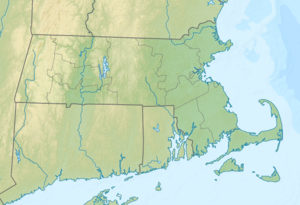Lovells Island
| Lovells Island | ||
|---|---|---|
| Sign on the island's jetty | ||
| Waters | Quincy Bay , Boston Harbor , Atlantic Ocean | |
| Geographical location | 42 ° 19 '46 " N , 70 ° 55' 49" W | |
|
|
||
| surface | 48.5 ha | |
| Highest elevation | 24 m | |
Lovells Island is an island in Quincy Bay in Boston Harbor . It is 7.2 mi (11.6 km ) from downtown Boston in the state of Massachusetts in the United States . It is administered by the Massachusetts Department of Conservation and Recreation (DCR) and is part of the Boston Harbor Islands National Recreation Area . Lovells Iceland has a permanent area of about 62 acres (25 ha ), which through a watt , depending on the tidal range is temporarily increased by up to 60 acres (24 ha).
geography
geology
The island consists of a wet meadow and three interconnected drumlins , the middle of which rises up to 79 ft (24.1 m ). On the otherwise rocky coast there is a beach in the northeast of the island. A 0.5 mi (0.8 km) long dune stretches along the south coast, and another, but much smaller, dune is on the north coast. The appearance and the topography of the island were changed by an artificial bank fortification and the construction of fortifications .
Flora and fauna
The oldest tree on Lovells Island is most likely the stump of a chestnut , from which viable branches still grow today. Most of the species planted on the island date from the 1930s when the Civilian Conservation Corps tried to recreate a natural forest. However, when the fort on the island was reactivated in the 1940s, most of the plants were removed.
After the Second World War , the island was left to its own devices. Few poplars , pines and spruces have survived from the 1930s ; have resettled among other vinegar trees , late blossoming bird cherry , bobwhite bird cherry , apple trees and gray birch .
The common shrubs include Myrica , Prunus , raspberries and roses . The meadow is largely covered with reeds , but there are also silt grasses , rushes , samphire and sea lavender growing in smaller areas . Beach grass also thrives in the island's dunes . Climbing poison sumac only grows in the area of the Terrill gun battery .
The island's fauna is also the subject of scientific research.
history

Before colonization by the Europeans, Indians settled seasonally on Lovells Island, later it was transferred to Charlestown for logging and fishing . Half of the wood was reserved for the construction of the fort on Castle Island . Since the island is positioned along the first waterway towards Boston, many wrecks were regularly in its vicinity , including the French 74-gun ship Magnifique, which sank on August 15, 1782 .
In 1902, two navigation lights were stationed on the island to aid ships arriving via the South Channel . In 1919, Charles Jennings , previously the lighthouse keeper of the Boston Light , was appointed keeper of the lighting system. As part of the expansion of Fort Standish on the island, the lights were dismantled in the late 1930s.
The appearance of the island was changed on the one hand by the construction of a bank fortification made of granite in the mid-1880s and on the other hand by the construction of military installations in the late 19th century. In 1958, the state of Massachusetts acquired ownership of the island.
Attractions
The island is open to visitors daily from 9:00 a.m. to sunset in summer. Particularly worth seeing are:
- Refuge for visitors near the pier
- Fort Standish with the gun batteries
- pier
- Bank reinforcement made of granite
Individual evidence
- ↑ a b c d e Island Facts: Lovells Island. National Park Service , accessed June 19, 2013 .

